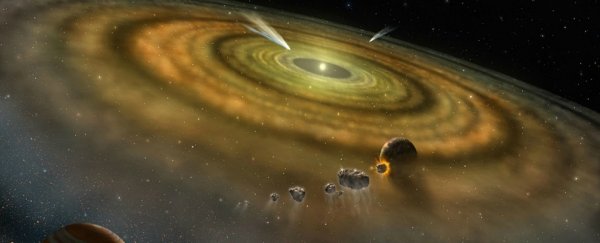The formation of our Solar System is complex and difficult to understand. Not only did it happen around 4.5 billion years before anyone was around to see it, but it also requires intricate computer simulations to recreate what might have occurred.
Scientists from Swinburne University of Technology in Australia and the University of Lyon in France have teamed up to create a two-dimensional map of the dust chemistry that would have been in the solar nebula - the dust cloud that formed the Solar System.
But first, let's get back to basics. The nebular hypothesis is the idea that the Solar System was formed by the collapse of a massive molecular cloud. This cloud had the density and size to produce important molecules and dust, which then clumped and collided together to eventually create the Solar System we know today.
Past research has focused on one-dimensional radial condensation sequences, which can only simulate one disc layer of the solar nebula at a time. This leaves room for error, and produces simulations that cannot adequately explain the global chemistry of the molecular cloud.
However, this new paper describes a model that has two dimensions, allowing researchers to understand the chemistry behind the system, as well as addressing the different zones of heavier elements within the solar nebula.
"The new two-dimensional calculations have given us a clearer idea of the pristine chemistry in our Solar System soon after its formation," said lead researcher Francesco Pignatale. "While solar nebular is thin, it is two-dimensional."
The inner Solar System was thought to be too warm for volatile molecules such as water and methane to condense. Instead planetesimals, or protoplanets close to our baby Sun would form compounds with high melting points such as metals and rocky silicates. Those in the outer Solar System are thought to have formed from volatile molecules only in the cooler temperatures. It was assumed that the dust distribution would show the same patterns.
However, when the new 2D maps were produced by the team, it revealed that some high-temperature materials were found at large distances from the Sun, and volatile materials were inside the inner disk.
"This makes it possible to find relatively high temperature regions at larger distances from the sun on the surface of the disk that are heated by the Sun's rays," Pignatale said. "We also find colder regions in the inner disk closer to the Sun. Here the high concentration of dust prevents the stellar radiation from efficiently heating the local environment."
This kind of research gives us a better look at how our Solar System formed and the complexities behind it. It's kind of crazy to think that we can make optical switches out of atoms, but we are still discovering how the Universe was created.
This research has been published in Monthly Notices of the Royal Astronomical Society.
Swinburne University of Technology is a sponsor of ScienceAlert. Find out more about their innovative research.
